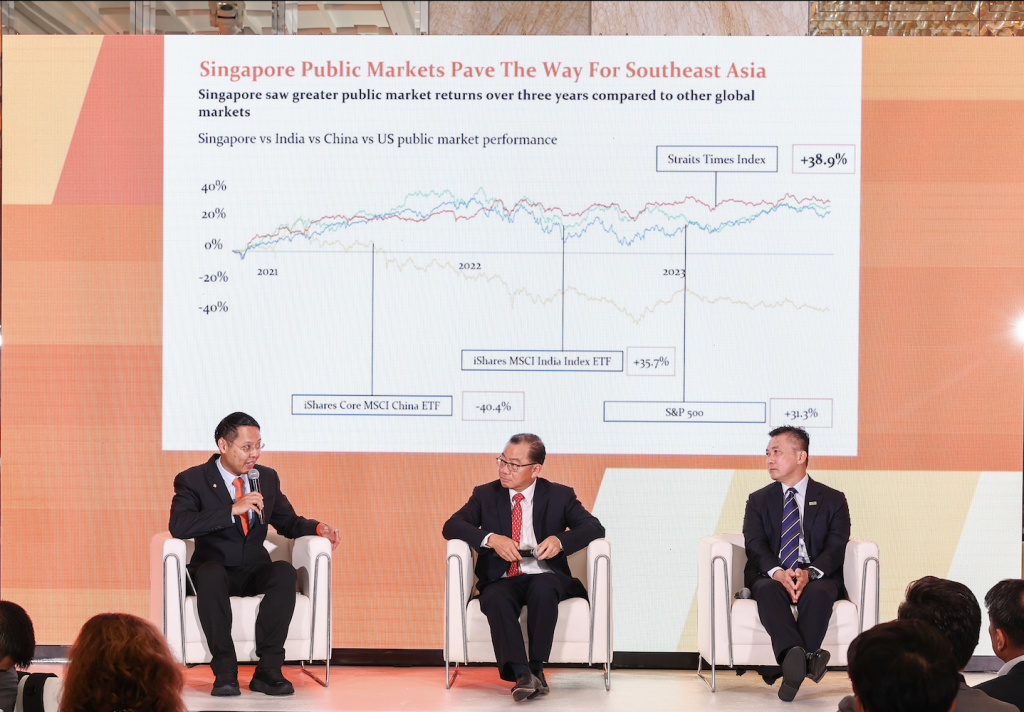
Photo from our sixth Annual Founders and Limited Partners Summit earlier this month. L-R: Yinglan Tan, Speaker of the House of Representatives of Singapore Seah Kian Peng, SGX CEO Loh Boon Chye
This photo was taken from our sixth Annual Founders and Limited Partners Summit earlier this month, when Yinglan Tan sat down with Speaker of the House of Representatives of Singapore Seah Kian Peng and SGX CEO Loh Boon Chye to talk about the Southeast Asia opportunity in today’s global landscape.
A slide was flashed to kick off the discussion, centered around Singapore’s stock index outperforming other indexes over a three year period — a notable statistic given the current macroeconomic environment, one that can be attributed to Singapore’s stability, rule of law, public private collaboration, and institutions like SGX
With this context in mind, along with what we have seen in the last five years in terms of technology and venture backed public market outcomes from the region, what then will the public market opportunities and narrative look like for the next generation of companies looking to make the transition?
We list five reasons to look forward to these opportunities:
1/ Deepening intersections across ASEAN exchanges paired with companies diversifying sources of capital for global growth
40% of companies on the Singapore stock exchange are from outside of Singapore. Companies from across the region are looking to leverage on international capital as they go global. And staying closer to home may be more optimal depending on the size of the company.
ASEAN exchanges are also building connectivity with each other, for example Singapore and Thailand, opening up possibilities for stocks of each market to be traded in either market through depository receipts.
2/ Patient capital influx into Singapore
As of 2022, there were 1100 family offices with wealth from across the globe set up in Singapore managing over US$66B in assets, accounting for 59% of Asia’s family offices. With the city state’s pull for capital only strengthening, there are opportunities to create more liquidity in the region and leverage for growth capital.
3/ Diversification of public market outcomes from Southeast Asia
While going to the US stock exchanges has always been a holy grail, it is not the only option for companies. We may see a broader pool of mid-sized companies going for regional exchanges earlier over the next few years.
However, this doesn’t discount the opportunities for companies with the right size and story to go public in the US and continue the SEA narrative in those bourses. There is likely to be even greater medium-term demand that can be filled by SEA companies given the void left by Chinese company IPOs amidst cross Pacific geopolitical tensions.
4/ The “corporate maturity” IPO narrative from Southeast Asia
This last generation of tech IPOs from Southeast Asia were built on the narrative of a massive, fast-growing, untapped emerging market region with a young, digitally-savvy population. The next generation are likely to still carry on this emerging market opportunity, layered on with even more developed corporate maturity for their size. This maturity is not just about profitability, but strong financial management that growth can be built on.
For example, in a recent article by Reuters, Carro CFO Ernest Chew cited that the company has already been audited to the PCAOB level, making it ready for an IPO in the US, even as no clear plans have been publicized (see link to article in comments).
Amidst the uncertainties on the path to an IPO, there are companies like Carro carefully laying the groundwork for an even stronger IPO narrative to come out of the region.
5/ The rising tide lifts all boats
We continue to believe the public markets are the best buyers of venture-backed companies. And more developed public market activity from companies in Southeast Asia, whether that’s IPOs in the region or abroad, will only strengthen the confidence of capital fueling innovation in the region (including the private markets).
With more capital fueling sustainable innovation, more jobs can be created, more entrepreneurs will take the plunge, and more livelihoods and standards of living can be improved — long-term outcomes that go beyond capital gains.
Paulo Joquiño is a writer and content producer for tech companies, and co-author of the book Navigating ASEANnovation. He is currently Editor of Insignia Business Review, the official publication of Insignia Ventures Partners, and senior content strategist for the venture capital firm, where he started right after graduation. As a university student, he took up multiple work opportunities in content and marketing for startups in Asia. These included interning as an associate at G3 Partners, a Seoul-based marketing agency for tech startups, running tech community engagements at coworking space and business community, ASPACE Philippines, and interning at workspace marketplace FlySpaces. He graduated with a BS Management Engineering at Ateneo de Manila University in 2019.